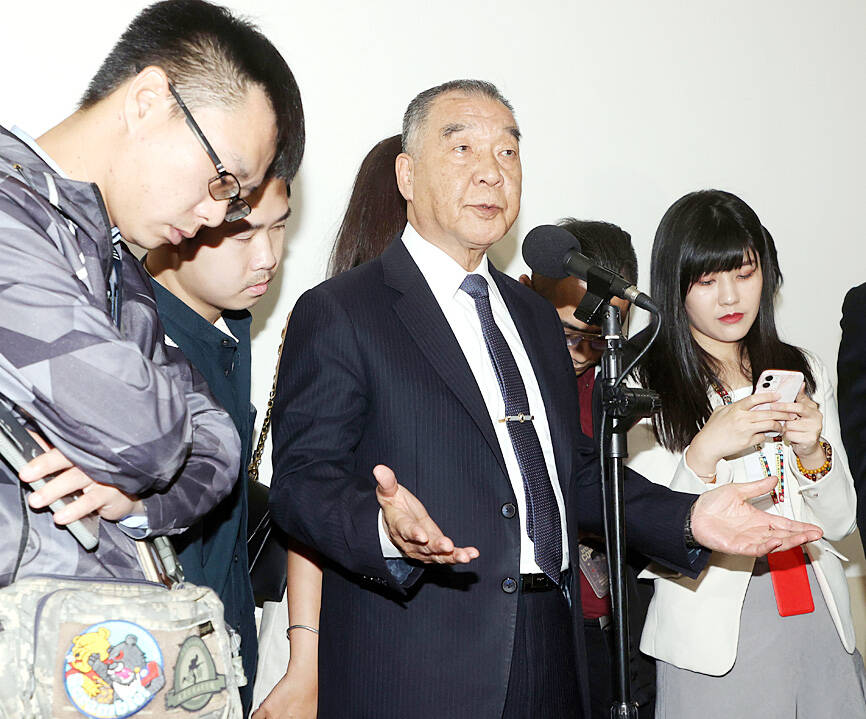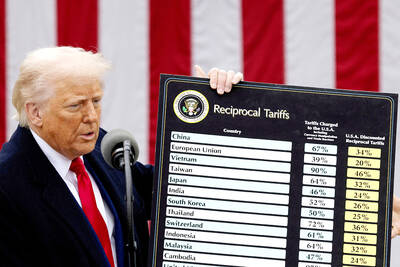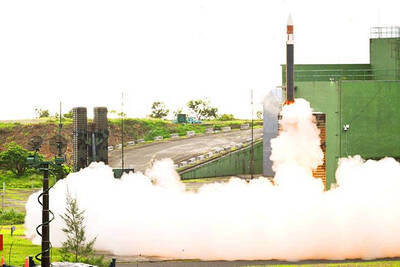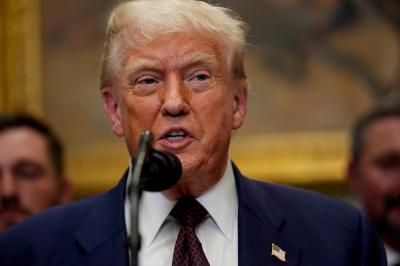A total of 41 US military personnel were stationed in Taiwan as of December last year, a US congressional report said on Friday last week ahead of Tuesday’s passage of an aid package that included US$8 billion for Taiwan.
The Congressional Research Service in a report titled Taiwan Defense Issues for Congress said that according to the US Department of Defense’s Defense Manpower Data Center, 41 US military personnel were assigned for duty in Taiwan.
Although the normalization of relations with the People’s Republic of China (PRC) in 1979 included a vow to withdraw a military presence from Taiwan, “observers have indicated that it is an ‘open secret’ that small numbers of US military personnel conduct work in an advisory capacity” in Taiwan, it said.

Photo: CNA
US defense officials have said they “do not have a comment on specific operations, engagements or training” related to engagements with Taiwan, the report said.
The Wall Street Journal in February last year reported that the US was to send 100 to 200 military training personnel to Taiwan “in the coming months,” which was not confirmed by officials on either side.
In February, US military news Web site SOFREP reported that US Green Berets were permanently stationed in Kinmen County to train Taiwanese forces, which US Indo-Pacific Commander Admiral John Aquilino denied.
SOFREP also highlighted challenges within Taiwan in relation to its defense, saying that there is an apparent lack of trust between elected leaders and the military, which has traditionally been aligned with the opposition Chinese Nationalist Party (KMT).
It also said that there was vulnerability in the nation’s energy, food, water and Internet supply, and it struggles to recruit, train and retain personnel.
“At a societal level, it is not clear what costs — in terms of economic security, physical safety and security, and lives — Taiwan’s people would be willing or able to bear in the face of possible PRC armed aggression,” SOFREP said.
The US and Taiwan “appear to be quietly expanding training activities,” while outlining recent and pending arms transfers to Taiwan, it added.
In other news, progress on stationing a US munitions stockpile in Taiwan is unclear, but there is an “approximate plan” in place, Minister of National Defense Chiu Kuo-cheng (邱國正) said yesterday in response to questions about whether Washington is moving forward with plans to move its East Asia stockpile to Taiwan.
Chiu was responding to a question from Democratic Progressive Party Legislator Wang Ting-yu (王定宇) about progress regarding the alleged stockpile.
On March 6 last year, Chiu told lawmakers that Taipei was “in talks” with the US military on moving its East Asia stockpile to Taiwan.
Chiu yesterday told a meeting of the legislature’s Foreign and National Defense Committee that the issue must be approached with caution, as it involves sensitive political considerations.
There are many ways to define a “stockpile,” he said, adding that the nature of armaments and weaponry is vastly different.
If it were a maintenance center, there would naturally be spare parts and equipment sent in, he said, adding that everything is still in the proposal stage and is open to discussion.

WAITING GAME: The US has so far only offered a ‘best rate tariff,’ which officials assume is about 15 percent, the same as Japan, a person familiar with the matter said Taiwan and the US have completed “technical consultations” regarding tariffs and a finalized rate is expected to be released soon, Executive Yuan spokeswoman Michelle Lee (李慧芝) told a news conference yesterday, as a 90-day pause on US President Donald Trump’s “reciprocal” tariffs is set to expire today. The two countries have reached a “certain degree of consensus” on issues such as tariffs, nontariff trade barriers, trade facilitation, supply chain resilience and economic security, Lee said. They also discussed opportunities for cooperation, investment and procurement, she said. A joint statement is still being negotiated and would be released once the US government has made

NEW GEAR: On top of the new Tien Kung IV air defense missiles, the military is expected to place orders for a new combat vehicle next year for delivery in 2028 Mass production of Tien Kung IV (Sky Bow IV) missiles is expected to start next year, with plans to order 122 pods, the Ministry of National Defense’s (MND) latest list of regulated military material showed. The document said that the armed forces would obtain 46 pods of the air defense missiles next year and 76 pods the year after that. The Tien Kung IV is designed to intercept cruise missiles and ballistic missiles to an altitude of 70km, compared with the 60km maximum altitude achieved by the Missile Segment Enhancement variant of PAC-3 systems. A defense source said yesterday that the number of

‘CRUDE’: The potential countermeasure is in response to South Africa renaming Taiwan’s representative offices and the insistence that it move out of Pretoria Taiwan is considering banning exports of semiconductors to South Africa after the latter unilaterally downgraded and changed the names of Taiwan’s two representative offices, the Ministry of Foreign Affairs (MOFA) said yesterday. On Monday last week, the South African Department of International Relations and Cooperation unilaterally released a statement saying that, as of April 1, the Taipei Liaison Offices in Pretoria and Cape Town had been renamed the “Taipei Commercial Office in Johannesburg” and the “Taipei Commercial Office in Cape Town.” Citing UN General Assembly Resolution 2758, it said that South Africa “recognizes the People’s Republic of China (PRC) as the sole

Taiwanese exports to the US are to be subject to a 20 percent tariff starting on Thursday next week, according to an executive order signed by US President Donald Trump yesterday. The 20 percent levy was the same as the tariffs imposed on Vietnam, Sri Lanka and Bangladesh by Trump. It was higher than the tariffs imposed on Japan, South Korea and the EU (15 percent), as well as those on the Philippines (19 percent). A Taiwan official with knowledge of the matter said it is a "phased" tariff rate, and negotiations would continue. "Once negotiations conclude, Taiwan will obtain a better